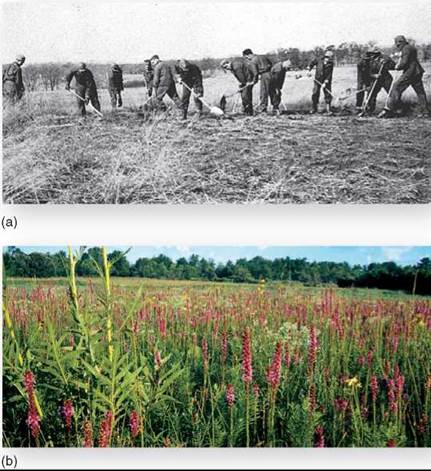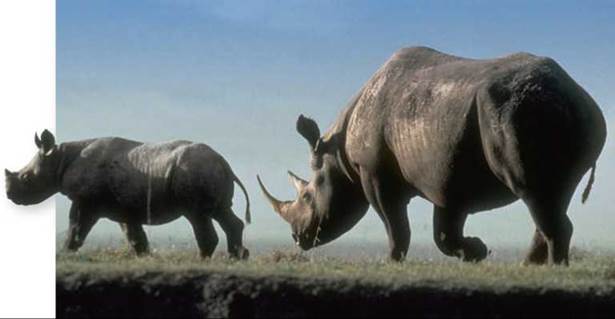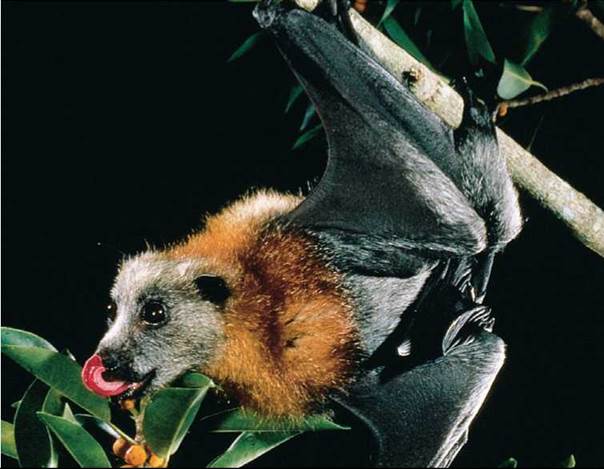THE LIVING WORLD
Unit Eight. The Living Environment
38. Human Influences on the Living World
38.9. Preservung Endangered Species
Once you understand the reasons why a particular species is endangered, it becomes possible to think of designing a recovery plan. If the cause is commercial overharvesting, regulations can be designed to lessen the impact and protect the threatened species. If the cause is habitat loss, plans can be instituted to restore lost habitat. Loss of genetic variability in isolated subpopulations can be countered by transplanting individuals from genetically different populations. Populations in immediate danger of extinction can be captured, introduced into a captive breeding program, and later reintroduced to other suitable habitats.
Of course, all of these solutions are extremely expensive. As Bruce Babbitt, Interior Secretary in the Clinton administration, noted, it is much more economical to prevent such “environmental trainwrecks” from occurring than it is to clean them up afterward. Preserving ecosystems and monitoring species before they are threatened is the most effective means of protecting the environment and preventing extinctions.
Habitat Restoration
Conservation biology typically concerns itself with preserving populations and species in danger of decline or extinction. Conservation, however, requires that there be something left to preserve, while in many situations, conservation is no longer an option. Species, and in some cases whole communities, have disappeared or have been irretrievably modified. The clear-cutting of the temperate forests of Washington State leaves little behind to conserve, nor does converting a piece of land into a wheat field or an asphalt parking lot. Redeeming these situations requires restoration rather than conservation.
Three quite different sorts of habitat restoration programs might be undertaken, depending very much on the cause of the habitat loss.
Pristine Restoration. In situations where all species have been effectively removed, one might attempt to restore the plants and animals that are believed to be the natural inhabitants of the area, when such information is available. When abandoned farmland is to be restored to prairie (figure 38.16), how do you know what to plant? Although it is in principle possible to reestablish each of the original species in their original proportions, rebuilding a community requires that you know the identity of all of the original inhabitants, and the ecologies of each of the species. We rarely ever have this much information, so no restoration is truly pristine.

Figure 38.16. Habitat restoration.
The University of Wisconsin-Madison Arboretum has pioneered restoration ecology. (a) The restoration of the prairie was at an early stage in November, 1935. (b) The prairie as it looks today. This picture was taken at approximately the same location as the 1935 photograph.
Removing Introduced Species. Sometimes the habitat of a species has been destroyed by a single introduced species. In such a case, habitat restoration involves removal of the introduced species. For example, Lake Victoria, Africa, was home to over 300 species of cichlid fishes, small perchlike fishes that display incredible diversity. However, in 1954, the Nile perch, a commercial fish with a voracious appetite, was introduced into Lake Victoria. For decades, these perch did not seem to have a significant impact, and then something happened to cause the Nile perch to explode and spread rapidly through the lake, eating their way through the cichlids. By 1986, over 70% of cichlid species had disappeared, including all open-water species.
The situation has been compounded by a second factor, the introduction into Lake Victoria of a floating water weed from South America, the water hyacinth Eichornia crassipes. Extremely prolific under eutrophic conditions, thick mats of water hyacinth soon covered entire bays and inlets, choking off the coastal habitats of non-open-water cichlids.
Restoration of the once-diverse cichlid fishes to Lake Victoria will require more than breeding and restocking the endangered species. Eutrophication will have to be reversed, and the introduced water hyacinth and Nile perch populations brought under control or removed.
Cleanup and Rehabilitation. Habitats seriously degraded by chemical pollution cannot be restored until the pollution is cleaned up. The successful restoration of the Nashua River in New England, discussed later in this chapter, is one example of how a concerted effort can succeed in restoring a heavily polluted habitat to a relatively pristine condition.
Captive Propagation
Recovery programs, particularly those focused on one or a few species, often must involve direct intervention in natural populations to avoid an immediate threat of extinction. Introducing wild-caught individuals into captive breeding programs is being used in an attempt to save the black-footed ferret and California condor populations in immediate danger of disappearing. Several other such captive propagation programs have had success.
Case History: The Peregrine Falcon. US. populations of birds of prey such as the peregrine falcon (Falco peregrinus) began an abrupt decline shortly after World War II. Of the approximately 350 breeding pairs east of the Mississippi River in 1942, all had disappeared by 1960. The culprit proved to be the chemical pesticide DDT and related organochlorine pesticides. Birds of prey are particularly vulnerable to DDT because they feed at the top of the food chain, where DDT becomes concentrated. DDT interferes with the deposition of calcium in the bird’s eggshells, causing most of the eggs to break before they hatch.
The use of DDT was banned by federal law in 1972, causing levels in the eastern United States to fall quickly. There were no peregrine falcons left in the eastern United States to reestablish a natural population, however. Falcons from other parts of the country were used to establish a captive breeding program at Cornell University in 1970, with the intent of reestablishing the peregrine falcon in the eastern United States by releasing offspring of these birds. By the end of 1986, over 850 birds had been released in 13 eastern states, producing an astonishingly strong recovery.
Sustaining Genetic Diversity
One of the chief obstacles to a successful species recovery program is that a species is generally in serious trouble by the time a recovery program is instituted. When populations become very small, much of their genetic diversity is lost. If a program is to have any chance of success, every effort must be made to sustain as much genetic diversity as possible.
Case History: The Black Rhino. All five species of rhinoceros are critically endangered. The three Asian species live in a forest habitat that is rapidly being destroyed, while the two African species are illegally killed for their horns. Fewer than 11,000 individuals of all five species survive today. The problem is intensified by the fact that many of the remaining animals live in very small, isolated populations. The 2,400 wild-living individuals of the black rhino, Diceros bicornis (figure 38.17), live in approximately 75 small, widely separated groups that are adapted to local conditions throughout the species’ range. All six subspecies appear to have low genetic variability; in three of the subspecies, only a few dozen animals remain. Analysis of mitochondrial DNA suggests that in these populations most individuals are genetically very similar.

Figure 38.17. Sustaining genetic diversity.
The black rhino is highly endangered, living in 75 small, widely separated populations. Only about 2,400 individuals survive in the wild. Conservation biologists have the difficult job of finding ways to preserve genetic diversity in small, isolated populations.
This lack of genetic variability represents one of the greatest challenges to the future of the species. Much of the range of the black rhino is still open and not yet subject to human encroachment. To have any significant chance of success, a species recovery program will have to find a way to sustain the genetic diversity that remains in this species. Heterozygosity could be best maintained by bringing all black rhinos together in a single breeding population, but this is not a practical possibility. A more feasible solution would be to move individuals between populations. Managing the black rhino populations for genetic diversity could prevent the loss of genetic variation, which might prove fatal to this species.
Placing black rhinos from a number of different locations together in a sanctuary to increase genetic diversity raises a potential problem: Local subspecies may be adapted in different ways to their immediate habitats—what if these local adaptations are crucial to their survival? Homogenizing the black rhino populations by pooling their genes risks destroying such local adaptations, perhaps at great cost to survival.
Keystone species are species that exert a particularly strong influence on the structure and functioning of their ecosystem. Their removal can have disastrous consequences.
Case History: Flying Foxes. The severe decline of many species of pteropodid bats, or “flying foxes,” in the Old World tropics is an example of how the loss of a keystone species can have dramatic effects on the other species living within an ecosystem, sometimes even leading to a cascade of further extinctions (figure 38.18). These bats have very close relationships with important plant species on the islands of the Pacific and Indian Oceans. The family Pteropodidae contains nearly 200 species, approximately a quarter of them in the genus Pteropus, and is widespread on the islands of the South Pacific, where they are the most important—and often the only—pollinators and seed dispersers. A study in Samoa found that 80% to 100% of the seeds landing on the ground during the dry season were deposited by flying foxes. Many species are entirely dependent on these bats for pollination.

Figure 38.18. Preserving keystone species.
The flying fox is a keystone species in many Old World tropical islands. It pollinates many of the plants, and is a key disperser of seeds. Its elimination by hunting and habitat loss is having a devastating effect on the ecosystems of many South Pacific islands.
In Guam, where the two local species of flying fox have recently been driven extinct or nearly so, the impact on the ecosystem appears to be substantial. Many plant species are not fruiting, or are doing so only marginally, with fewer fruits than normal. Fruits are not being dispersed away from parent plants, so offspring shoots are being crowded out by the adults.
Flying foxes are being driven to extinction by human hunting. They are hunted for food, for sport, and by orchard farmers, who consider them pests. Flying foxes are particularly vulnerable because they live in large, easily seen groups of up to a million individuals. Because they move in regular and predictable patterns and can be tracked to their home roost, hunters can easily bag thousands at a time.
Species preservation programs aimed at preserving particular species of flying foxes are only just beginning. One particularly successful example is the program to save the Rodrigues fruit bat, Pteropus rodricensis, which occurs only on Rodrigues Island in the Indian Ocean near Madagascar. The population dropped from about 1,000 individuals in 1955 to fewer than 100 by 1974, the drop reflecting largely the loss of the fruit bat’s forest habitat to farming. Since 1974 the species has been legally protected, and the forest area of the island is being increased through a tree-planting program. Eleven captive breeding colonies have been established, and the bat population is now increasing rapidly. The combination of legal protection, habitat restoration, and captive breeding has in this instance produced a very effective preservation program.
Conservation of Ecosystems
Habitat fragmentation is one of the most pervasive enemies of biodiversity conservation efforts. Some species simply require large patches of habitat to thrive, and conservation efforts that cannot provide suitable habitat of such a size are doomed to failure. As it has become clear that isolated patches of habitat lose species far more rapidly than large preserves do, conservation biologists have promoted the creation, particularly in the tropics, of so-called mega-reserves—large areas of land containing a core of one or more undisturbed habitats.
In addition to this focus on maintaining large enough reserves, in recent years, conservation biologists also have recognized that the best way to preserve biodiversity is to focus on preserving intact ecosystems, rather than focusing on particular species. For this reason, attention in many cases is turning to identifying those ecosystems most in need of preservation and devising the means to protect not only the species within the ecosystem, but the functioning of the ecosystem itself.
Key Learning Outcome 38.9. Recovery programs at the species level must deal with habitat loss and fragmentation, and often with a marked reduction in genetic diversity.